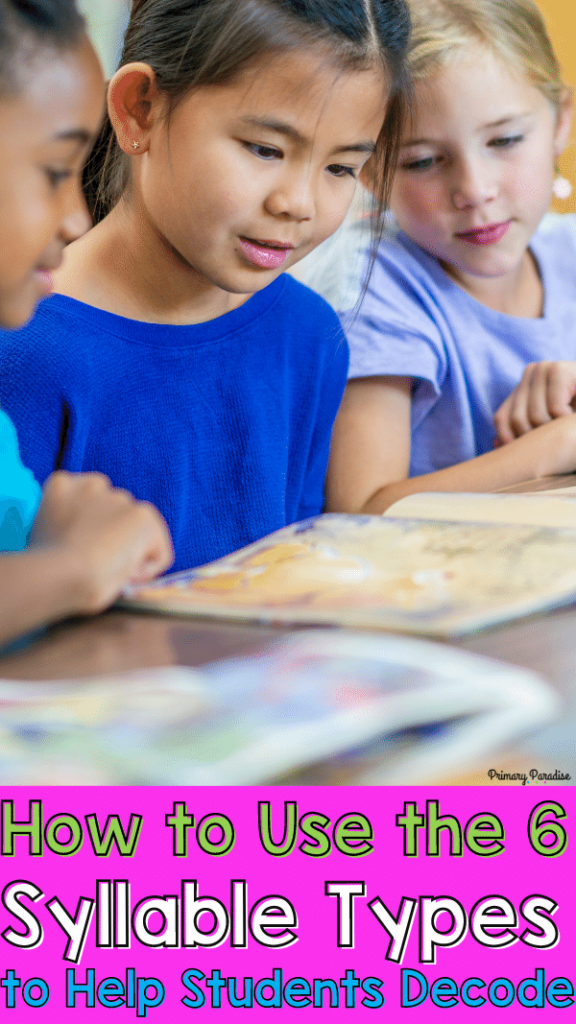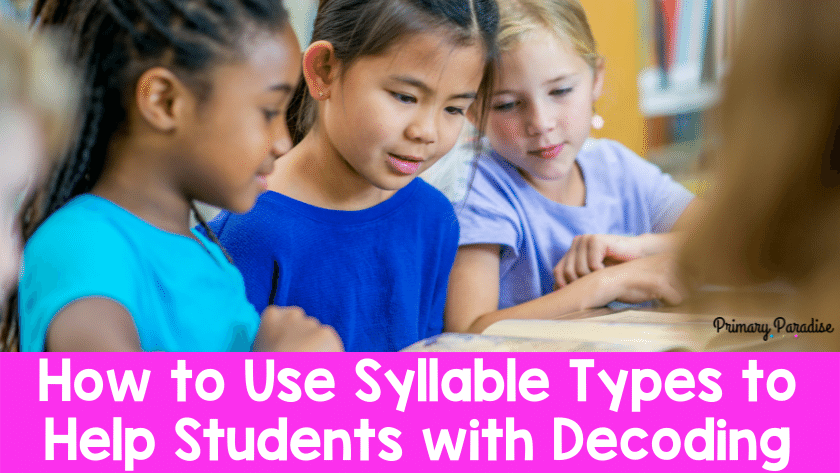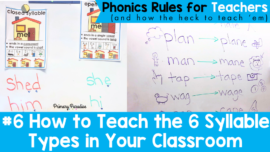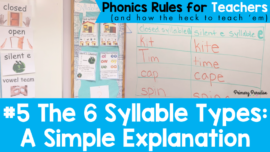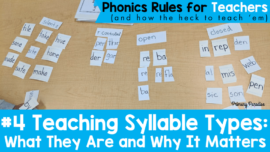Helping students to decode can feel overwhelming. What do you do when older students, say 2nd, 3rd, and 4th graders, are struggling to decode words that should come easily? It can feel like a conundrum. You don’t want to give them “baby” practice, but it’s important to review foundational ideas and skills that will give them the tools they need. I’ve found as an intervention teacher that the solution is relatively simple: teach them about syllable types. I’ve also found that this works best if it’s taught along with sound patterns when students are in kindergarten and first grade, but if that didn’t happen, it’s not too late. Here is how you can use syllable types to help students of all ages decode.
Why are syllables helpful for students struggling to decode?
You might be wondering what syllables have to do with decoding. After all, of course we teach our students to clap or tap them out, but is there more to it than that? (and have you always wondered why we even do that in the first place?) The answer is a big YES! However, that is the first step. Students do need to understand how to hear and feel syllables in words. So, first, take time to make sure they’re able to do that. I like to use this simple chant (you can grab this and all resources pictured at the bottom of this post).
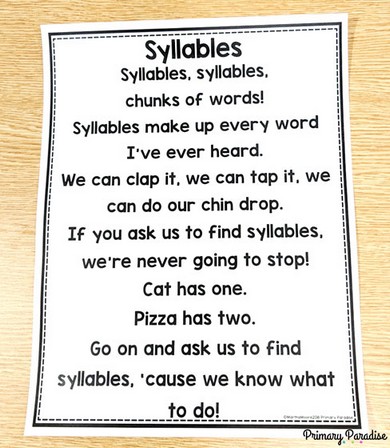
Once students know how to hear and feel syllables in a word, the real learning can begin! Syllables are super helpful for teaching students to decode because there are 6 different syllable types that will help students decode easily. Once they learn each type, they can look at words and figure out what syllable types make up the word. This will help them know how to break down the word and say each vowel sounds (which often is the hardest part of decoding). Instead of telling them to chunk it and expecting them to know where to find each chunk, understanding syllable types helps them know with confidence how to chunk words.
What are the six syllable types and how can you teach them?
The six common syllable types are open, closed, CVCe, vowel team, r-controlled, and consonant le. After you’ve talked about how to clap or tap them out, tell your students that there are different kinds of syllables. Then, teach one syllable at a time. Depending on how quickly students pick it up, this could take a few lessons or a few weeks. Don’t force it because this will only be helpful to them if if they really “get it”. I use syllable fans to help my students keep track of their learning, sorts and underlining activities to help them practice, and, most importantly, when they get stuck on a word during guided reading, we stop and try to break down the word.
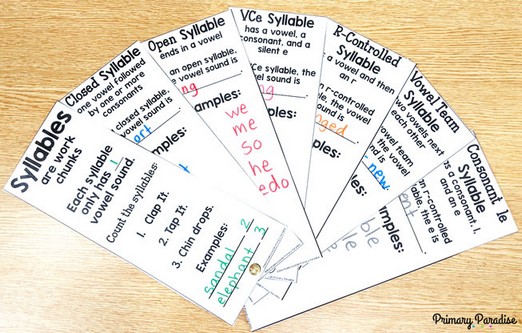
Here is the order in which I like to teach syllable types:
Closed Syllable: has a short vowel sound and ends in a consonant. Closed syllables make up many words in the English language. I tell students that the ending consonant closes the vowel in so it makes a short vowel sound. (Be sure to review the sounds short vowels make). Closed syllables are basically CVC words (or nonsense words), although they don’t HAVE to have a consonant in the front. Sometimes we see them simply as a vowel and then a consonant. Start with having students identify and then come up with their own one syllable words. Next, build to two and three syllable words. There are lots of words that are only made up with closed syllables.
Examples of words with closed syllables: man, club, rash, happen (hap/pen) on, pocket, (pock/et), problem (prob/lem), fantastic (fan/tas/tic), bathtub (bath/tub), basketball (bas/ket/ball), magnetic (mag/net/ic), panic (pan/ic).
Open Syllable: open syllables are basically the opposite of closed syllables. They have a long vowel sound and end in a vowel. This is a great opportunity to review the long vowel sounds and the fact that y can often take the place of a the i and e vowel sounds. We often see open syllables at the beginning of words, but they can also be found in the middle and the end. I tell my students that, because the vowel isn’t closed in, he’s open to saying his name. Again, start with one syllable words. You can move to multi-syllabic words, with both open and closed syllables when you’re ready. In the examples below, I will share words with both open and closed syllables. The open syllables will be bold.
Examples of words with open syllables: no, go, my, fly, we, she, retry (re/try), I, redo (re/do), electron (e/lec/tron), latest (la/test), balcony, (bal/co/ny), April (A/pril), potato (po/ta/to), moment (mo/ment), basic (ba/sic).
CVCe Syllable: has a long vowel sound. You might call it magic e, sneaky e, or silent e depending on which your students are already familiar with. This type of syllable is often found at the end of words, and is used to make many one syllable words. In the examples, CVCe syllables will be bold.
Examples of words with CVCe syllables: bike, made, globe, home, rose, hope, volume (vol/ume), explode (ex/plode), illustrate (il/lus/trate), milestone (mile/stone), homemade (home/made), compensate (com/pen/sate).
R Controlled Syllable: r controlled syllables have an r controlled vowel in them (ar, er, ir, or, ur), and I tell my students that the vowel is changed. Before focusing on the syllables themselves, be sure to review the sound each pair makes. (Part of the beauty of teaching syllable types is the opportunity to review these sounds.) In the examples, r controlled syllables will be bold.
Examples of words with r controlled syllables: bark, horn, her, bird, turn, harmful (harm/ful), monster (mon/ster), backward (back/ward), inventor (in/ven/tor), perfect (per/fect), legislator (leg/i/sla/tor), remember (re/mem/ber).
Vowel Teams Syllable: vowel team syllables have a pair of vowels, or a variant pair of vowels that make a new sound. Sometimes the sound is long, like oa or ee, but sometimes the sound is different/new like ou or oi. This is also a perfect opportunity to remind students that sometimes y acts as a vowel. Sometimes people choose to teach long vowel teams and variant vowel syllables separately, but, because it really comes down to students understanding the sound each vowel team makes, I put them together and spend time on each vowel team sound. It’s not a perfect method either way, but nothing in English ever is. In the examples, vowel team syllables will be bold.
Examples of words with vowel team syllables: south, seek, book, mail, praise, boastful (boast/ful), untie (un/tie), looking (look/ing), again (a/gain), Monday (Mon/day), treetop (tree/top), monkey (mon/key), cookout (cook/out).
Consonant le Syllable: makes the /l/ sound and is typically found at the end of words. I typically teach this syllable pattern last because, it is somewhat common, but I find students don’t struggle as much with decoding this as they do the first 5 syllable types we discussed. It’s also always part of a word with at least one other syllable types. In the examples, le syllables will be bold.
Example of words with consonant le syllables: handle (han/dle), puzzle (puz/zle), bugle (bu/gle), bumblebee (bum/ble/bee), turtle (tur/tle), freckle (freck/le), wobble (wob/ble), drizzle (driz/zle), thistle (this/tle), wrestle (wrest/le).
Syllable Activities
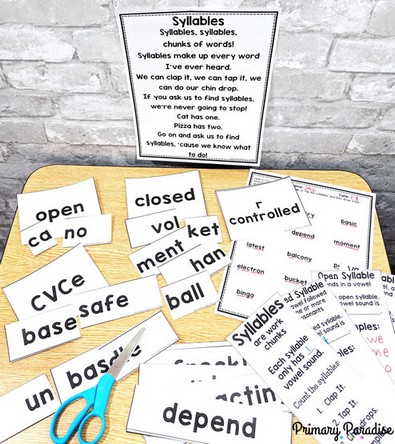
As students are learning the syllable types, I use a few activities that help them spot each type in words. Again, the final goal here is for them to be able to decode in context, but first they need to be able to identify and read syllable types in isolation. The hope is the, eventually through these activities and then also reading in context, decoding becomes fluid. Here are some simple activities I’ve found very helpful.
1. Syllable Cut Up- Give students words with 2 or more syllables on note cards or sentence strips. Have them read the word and then cut a part where they hear the syllable breaks. This activity can be done before they’ve even learned the syllable types, although I wait until they’ve at least learned about closed syllables.
2. Syllable Puzzles– Give students parts of words, broken into syllables on sentence strips or note cards. Have them try to put syllables together to make coherent words. (This can be hard, so start with a small amount of words, maybe 3-5.) Be sure that all words only contain syllable types that students already know.
3. Syllable Type Sort– I often use this in the mix with the first two activities. Have students take different syllables (you can save them from the cards in activity 1 and 2) and sort them by syllable type. Keep the cards and as you learn new syllables, you can continue to sort them.
4. Silly Syllable Words– I also often use this activity with the syllable type sort. After they’ve sorted their syllables, have students pull 2-3 syllables down and build new “silly” words. This is similar to how we have students practice CVC nonsense words. If they’re able to correctly read the silly words, it shows they understand how those syllable types work. Plus, students really enjoy this activity!
5. Syllable Mark Up- Lastly, I like to give students white boards and a word to mark up. First, I have them underline each syllable. Then, I have them identify each syllable type in the word. Students can do this either verbally or they can write it.
6. READ!- Lastly, having students read with you in guided reading is a great way to practice decoding using syllables. While reading, have them find words with the syllable types you’ve learned. If students are stuck on a word, prompt them to look for the different syllable types.
Exceptions to Syllable Types
Of course, just like everything in the English language, syllable types aren’t accurate 100% of the time. There are plenty of words that break the rules such as love, steak, give, live, sweat, olive, and inventive. However, they are accurate much of the time and can really be a fantastic tool for your students to pull out as their decoding. How do you teach those “rule breaker! words? You teach about heart parts and word mapping.
You can grab the syllable resources pictured in this post in my free resource library for subscribers(Subscribe here to get the password)!
You can join my FREE Facebook Club for k-2 teachers here!
Find me on Instagram, Facebook, Twitter, and Pinterest!
